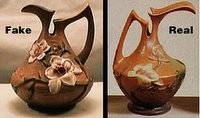NEW NATO ALLIANCE? TROUBLE AHEAD - NOT NECESSARILY!
The Financial Times has just informed the IPKat that the United States and the European Union will pledge tomorrow to take joint action to stem the world’s swelling tide of fake goods. Following a tenfold rise in trade in counterfeits in the past six years, the EU and the US propose to share intelligence and to coordinate policy at international bodies such as the World Intellectual Property Organisation, aiming first at Russia and China, then at Latin America and the Middle East.
EU authorities are reported to have seized more than 103 million items of counterfeit goods in 2004, up from just 10 million in 1998. A European official adds:
“The lion’s share were heading for the least developed countries in the world. This is not just a rich-country problem. And what we seize is just the tip of the iceberg”.In 1997 the Organisation for Economic Co-operation and Development estimated that counterfeits accounted for 5 to 7 per cent of world trade. They cost global business more than €250bn ($316bn, £171bn) and threaten 200,000 jobs in Europe, according to the International Chamber of Commerce.
 The IPKat notes that it's the old NATO partners ganging up against the Eastern threat again. Wouldn't it be nice, though, if we were all on the same side? After all, fake medicines and brake-pads will harm the Chinese and the Russians as much as they harm us - and which governments, East or West, benefit from trading that doesn't show up in the official books, if it can't be taxed or controlled? Merpel wonders if the big dealers in counterfeits in the East are the equivalent of War Lords, with their feifdoms and the money to buy the loyal support of their followers.
The IPKat notes that it's the old NATO partners ganging up against the Eastern threat again. Wouldn't it be nice, though, if we were all on the same side? After all, fake medicines and brake-pads will harm the Chinese and the Russians as much as they harm us - and which governments, East or West, benefit from trading that doesn't show up in the official books, if it can't be taxed or controlled? Merpel wonders if the big dealers in counterfeits in the East are the equivalent of War Lords, with their feifdoms and the money to buy the loyal support of their followers.Trouble ahead - not necessarily!

There May be Trouble Ahead is the alarming title of a cute little book by Lex van Wijk, subtitled "a practical guide to effective patent asset management". The author (right), a patent attorney who has worked at Royal Dutch Shell, at Burmah Castrol as group patent manager,and at Siemens AG, now works at Vereenigde, where he advises clients on intellectual property matters.
What the publisher says:
"Patent assets are currently important strategic business tools. Their presence or absence can make or break technology-based companies. Patent asset management has therefore become a core responsibility within companies. This book discusses in a lucid manner the elements that need to be covered to ensure that patent assets are used to their full potential. It provides simple and practical management tools to realize alignment of patent, business, and research & development strategies. Additionally, this book will help managers understand why any decision regarding patent assets needs to be an informed business decision, and how these assets can contribute to the company's future success, if not survival".
"As the author says in his Preface, these are awkward times for in-house patent professionals. They are even harder now, with the outbreak of "trollism" in the United States raising questions that CEOs aim at blameless patent staff along the lines of either 'what can we do about these patent trolls?' or 'why can't we be trolls too?'. This book won't make things easier for the patent pro, but it will give him a better idea of which problems he can deal with and which he should duck or pass on to someone else. The main problem facing in-house patent pros is that they are often expected to be omniscient polymaths, coping with economic, legal and strategic issues while exercising management skills. A second problem is that much of the information that any in-house patent pro needs in order to dispense good advice is simply not available to him - or not easily accessible - at the time he most needs it. This book will direct him to the information he most keenly needs when steering his company's patent assets clear of the many obstacles (self-induced and otherwise) that must be negotiated on the path from expenditure to profit".Bibliographic details. Published by Scarecrow Press, Inc (Lanham, Maryland; Toronto; Oxford, 2005). Paperback, xvi + 120 pages. Rupture factor - non-existent.